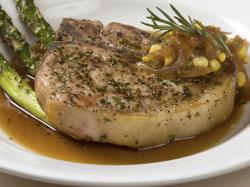Compart Family Farms Pioneering Dry-Aged Pork
September 22, 2010 | 2 min to read

The dry-aged porterhouse served at FireLake restaurant is marked with grill hashes and flecked with spices and herbs. It's banded by a thick strap of fat and split down the middle with a T-shaped bone. The meat's tender, juicy interior contrasts its carnitas-like crust, and its flavor is deep, almost concentrated. It's exactly what you'd expect to find at a world-class steakhouse. Except that it's pork, not beef.
FireLake chef Paul Lynch worked with the pork's producer, Compart Family Farms, to road test a variety of cuts and dry-aging techniques as they developed a pork product worthy of a place on a high-end steakhouse menu. Lynch thinks that Americans, a nation of grillers, often overlook pork because the meat hasn't had a cookout-style "steak" as part of its identity—and that Compart's dry-aged porterhouse could help change that mentality. "Now you have a piece of pork you can understand," he says. "You will recognize it as a steak and you will eat it as a steak. If it were a blind tasting, you would be saying, 'Is this beef…veal…pork?' You wouldn't expect the richness and meatiness. It's not strange, just unidentified. You'll recognize it like a long-lost cousin."
Compart debuted its dry-aged pork at last year's National Restaurant Association Show, and became the first major producer in the country to sell the product commercially. The dry-aging process—hanging top-grade meat in a specialized cooler for several weeks as it loses moisture, tenderizes, and intensifies in flavor—improves the character of beef, and its pricey steaks are hard to find outside of upscale restaurants. (Typically, of course, fresher is better when it comes to food, but just-butchered beef can actually have unpleasant sour, metallic flavors. Commercial beef is commonly "aged," or held in a refrigerated state for several days between the time the animal is slaughtered and broken down into retail cuts. Most beef is wet-aged in vacuum-sealed bags, with just a small percentage undergoing the more complex, and costly, dry-aging process.) But the dry-aging process hadn't proved successful for pork; the meat was thought to be too lean. That is, until the Comparts discovered that they were breeding just the right pig.
To read the rest of this story please go to: The City Pages
